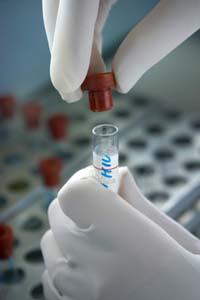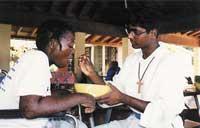What they did not say
2009/12/12 Galarraga Aiestaran, Ana - Elhuyar Zientzia

Perhaps by prudence they have silenced this subject. Perhaps they feared to be wrong, recalling the mistake made by the U.S. health officer at the time they discovered AIDS: one year after the isolation of the virus, in 1984, he announced that in two years the AIDS vaccine would be in the test phase. Unfortunately he did not succeed.
There is still no vaccine. There is something to say, however, because at the beginning of autumn the media spread almost unfavorable or, at least, encouraging news. In fact, according to the U.S. military and Thailand's health ministry, the vaccine that was being tested was successful. It reduced the risk of AIDS infection by 31%. It was not so good that the vaccine was marketed as it was, but it was the best that had been achieved so far. They were on the good way.
It began testing in 2003 and was in the last phase before its launch (III. Phase). The vaccine is a combination of the two existing vaccines containing HIV genes and a skin protein. 16,400 Thai volunteers tested it; half took a placebo and the other half, the vaccine. Subsequently, both groups measured the number of infected people and the number of virus in blood contained in the infected. In view of all these results, it was concluded that the vaccine was "successful," although it only partially protected.
A month later, all the data from the experiment was presented at an AIDS congress in Paris. The head of the research, Reks-Ngarm, of the Ministry of Health of Thailand, said his research was "a milestone in the research of AIDS vaccines" and the scientists present applauded it.
From applause to criticism
Subsequently, the applause became critical. In fact, they had the opportunity to analyze the results well and found that the data collected in the experiment were analyzed in three ways. And 31% supported that the result was the best of the three, while the other two did not reach 26%. Therefore, the data were not significant, they were not appreciable.
In quantitative terms, we can see more clearly than in percentage the small difference between those who were vaccinated and those who did not: Of these 11,600 volunteers, in the group of those who were integrated, only 51 were contaminated. And 74 for those who replaced the vaccine by placebo. That is, there was a difference of 23 people.
According to some researchers, the result was also disappointing in terms of the number of viruses they had in the blood. There are vaccines that, although they do not fully protect from infection, prevent the proliferation of the virus, thus avoiding the development of symptoms. But that vaccine also failed to achieve it.
That is, the actual results were far from those initially announced. The critics did not have as much repercussion in the media as the September forecast, and since then it has hardly been heard of the vaccine.
However, researchers are still working. In that experiment, 119 million dollars were spent, which in the coming years will be destined even more to vaccination. However, there are other proposals: using a mathematical model, at the Canadian University of Ottawa it has been concluded that with $65 million in 5 years the plague would be stopped. They have also detailed what to spend on: retroviral, educational campaigns and condoms aimed at everyone. Will anyone sustain the entanglement?
Published in Gara

Gai honi buruzko eduki gehiago
Elhuyarrek garatutako teknologia






